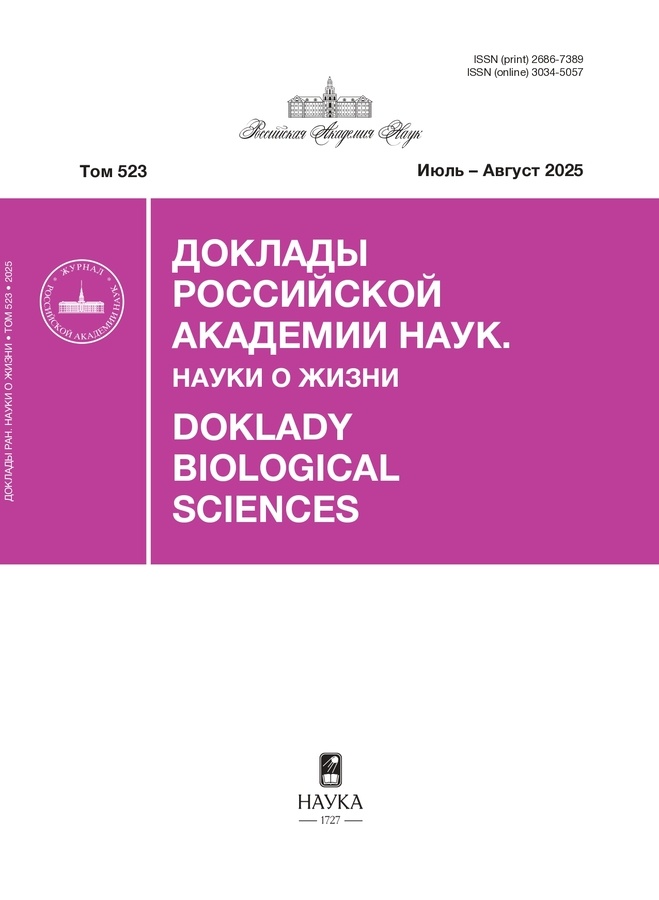Changes in the repertoire of extracellular vesicles secreted by skin keratinocytes by the human protein SLURP-2
- Authors: Gornostaeva T.Y.1,2, Shlepova O.V.1, Kukushkin I.D.1,2, Paramonov A.S.2, Kirpichnikov М.P.2,3, Lyukmanova Е.N.1,2,3,4
-
Affiliations:
- Shemyakin-Ovchinnikov Institute of Bioorganic Chemistry of the Russian Academy of Sciences
- Moscow Center for Advanced Studies
- Lomonosov Moscow State University
- Shenzhen MSU-BIT University
- Issue: Vol 521, No 1 (2025)
- Pages: 208-213
- Section: Articles
- URL: https://vestnik.nvsu.ru/2686-7389/article/view/684008
- DOI: https://doi.org/10.31857/S2686738925020078
- ID: 684008
Cite item
Abstract
Extracellular vesicles secreted by keratinocytes are participants of intercellular interactions, and contain various proteins, mRNA and miRNA, lipids, due to which they can activate cell migration and proliferation. The secreted human protein SLURP-2 regulates growth and differentiation of epithelial cells, affects proliferation and migration of keratinocytes. In this work, we showed that extracellular vesicles secreted by keratinocytes in presence of SLURP-2 stimulate migration of HaCaT keratinocytes. It was also found that, expression of miRNA-96 and miRNA-183, suppressing cell migration and proliferation, is decreased in the vesicles secreted by keratinocytes in presence of SLURP-2. Thus, it has been shown that the stimulation of keratinocyte migration in presence of SLURP-2 is associated, among others, with a change in the repertoire of extracellular vesicles secreted by these cells.
Full Text
About the authors
T. Y. Gornostaeva
Shemyakin-Ovchinnikov Institute of Bioorganic Chemistry of the Russian Academy of Sciences; Moscow Center for Advanced Studies
Email: lyukmanova_ekaterina@smbu.edu.cn
Russian Federation, Moscow; Moscow
O. V. Shlepova
Shemyakin-Ovchinnikov Institute of Bioorganic Chemistry of the Russian Academy of Sciences
Email: lyukmanova_ekaterina@smbu.edu.cn
Russian Federation, Moscow
I. D. Kukushkin
Shemyakin-Ovchinnikov Institute of Bioorganic Chemistry of the Russian Academy of Sciences; Moscow Center for Advanced Studies
Email: lyukmanova_ekaterina@smbu.edu.cn
Russian Federation, Moscow; Moscow
A. S. Paramonov
Moscow Center for Advanced Studies
Email: lyukmanova_ekaterina@smbu.edu.cn
Russian Federation, Moscow
М. P. Kirpichnikov
Moscow Center for Advanced Studies; Lomonosov Moscow State University
Email: lyukmanova_ekaterina@smbu.edu.cn
Interdisciplinary Scientific and Educational School of Moscow University “ Molecular Technologies of the Living Systems and Synthetic Biology”, Faculty of Biology, Academician of the RAS
Russian Federation, Moscow; MoscowЕ. N. Lyukmanova
Shemyakin-Ovchinnikov Institute of Bioorganic Chemistry of the Russian Academy of Sciences; Moscow Center for Advanced Studies; Lomonosov Moscow State University; Shenzhen MSU-BIT University
Author for correspondence.
Email: lyukmanova_ekaterina@smbu.edu.cn
Interdisciplinary Scientific and Educational School of Moscow University “ Molecular Technologies of the Living Systems and Synthetic Biology”, Faculty of Biology
Russian Federation, Moscow; Moscow; Moscow; International University Park Road 1, Dayun New Town, Longgang District, Shenzhen, Guangdong Province, 518172 PRCReferences
- Peña O.A., Martin P. Cellular and molecular mechanisms of skin wound healing // Nat. Rev. Mol. Cell Biol. Nature Publishing Group, 2024. Vol. 25, № 8. P. 599–616.
- Colombo M., Raposo G., Théry C. Biogenesis, secretion, and intercellular interactions of exosomes and other extracellular vesicles // Annu. Rev. Cell Dev. Biol. 2014. Vol. 30. P. 255–289.
- Glady A., Vandebroek A., Yasui M. Human keratinocyte-derived extracellular vesicles activate the MAPKinase pathway and promote cell migration and proliferation in vitro // Inflamm. Regen. 2021. Vol. 41. P. 4.
- Narauskaitė D., Vydmantaitė G., Rusteikaitė J., et al. Extracellular Vesicles in Skin Wound Healing // Pharmaceuticals. 2021. Vol. 14, № 8. P. 811.
- Arredondo J., Chernyavsky A.I., Jolkovsky D.L., et al. SLURP-2: A novel cholinergic signaling peptide in human mucocutaneous epithelium // J. Cell. Physiol. 2006. Vol. 208, № 1. P. 238–245.
- Arredondo J., Chernyavsky A.I., Grando S.A. SLURP-1 and -2 in normal, immortalized and malignant oral keratinocytes // Life Sci. 2007. Vol. 80, № 24–25. P. 2243–2247.
- Bychkov M.L., Shlepova O.V., Shulepko M.A., et al. Human Epithelial Protein SLURP-2 as a Prototype of Drugs for Wound Healing // Russ. J. Bioorganic Chem. 2024. Vol. 50, № 3. P. 696–705.
- Lyukmanova E., Shulepko MA., Shenkarev Z., et al. Secreted Isoform of Human Lynx1 (SLURP-2): Spatial Structure and Pharmacology of Interactions with Different Types of Acetylcholine Receptors // Sci. Rep. 2016. Vol. 6, № 1.
- Chernyavsky A.I., Kalantari-Dehaghi M., Phillips C., et al. Novel cholinergic peptides SLURP-1 and -2 regulate epithelialization of cutaneous and oral wounds // Wound Repair Regen. Off. Publ. Wound Heal. Soc. Eur. Tissue Repair Soc. 2012. Vol. 20, № 1. P. 103–113.
- Lyukmanova E.N., Shulepko M.A., Bychkov M.L., et al. Human SLURP-1 and SLURP-2 Proteins Acting on Nicotinic Acetylcholine Receptors Reduce Proliferation of Human Colorectal Adenocarcinoma HT-29 Cells // Acta Naturae. 2014. Vol. 6, № 4. P. 60–66.
- Bychkov M.L., Kirichenko A.V., Mikhaylova I.N., et al. Extracellular Vesicles Derived from Metastatic Melanoma Cells Transfer α7-nAChR mRNA, Thus Increasing the Surface Expression of the Receptor and Stimulating the Growth of Normal Keratinocytes // Acta Naturae. 2022. Vol. 14, № 3. P. 95–99.
- Zhu J., Liu B., Wang Z., et al. Exosomes from nicotine-stimulated macrophages accelerate atherosclerosis through miR-21-3p/PTEN-mediated VSMC migration and proliferation // Theranostics. 2019. Vol. 9, № 23. P. 6901–6919.
- Pathan M., Fonseka P., Chitti S.V., et al. Vesiclepedia 2019: a compendium of RNA, proteins, lipids and metabolites in extracellular vesicles // Nucleic Acids Res. 2019. Vol. 47, № D1. P. D516–D519.
- Siu M.C., Voisey J., Zang T., et al. MicroRNAs involved in human skin burns, wound healing and scarring // Wound Repair Regen. Off. Publ. Wound Heal. Soc. Eur. Tissue Repair Soc. 2023. Vol. 31, № 4. P. 439–453.
- Wu P., Cao Y., Zhao R., et al. miR-96-5p regulates wound healing by targeting BNIP3/FAK pathway // J. Cell. Biochem. 2019. Vol. 120, № 8. P. 12904–12911.
- T L., X Z., Y W. miR-183-3p suppresses proliferation and migration of keratinocyte in psoriasis by inhibiting GAB1 // Hereditas. Hereditas, 2020. Vol. 157, № 1.
- Viticchiè G., Lena A.M., Cianfarani F., et al. MicroRNA-203 contributes to skin re-epithelialization // Cell Death Dis. 2012. Vol. 3, № 11. P. e435.
- Liu A., Zhang B., Zhao W., et al. MicroRNA-215-5p inhibits the proliferation of keratinocytes and alleviates psoriasis-like inflammation by negatively regulating DYRK1A and its downstream signalling pathways // Exp. Dermatol. 2021. Vol. 30, № 7. P. 932–942.
- Z M., J Q., H Z. MiR-221-3p as a Potential Biomarker for Patients with Psoriasis and Its Role in Inflammatory Responses in Keratinocytes // Skin Pharmacol. Physiol. Skin Pharmacol Physiol, 2021. Vol. 34, № 5.
- Chao L., Hua-Yu Z., Wen-Dong B., et al. miR-96 promotes collagen deposition in keloids by targeting Smad7 // Exp. Ther. Med. 2019. Vol. 17, № 1. P. 773–781.
Supplementary files











